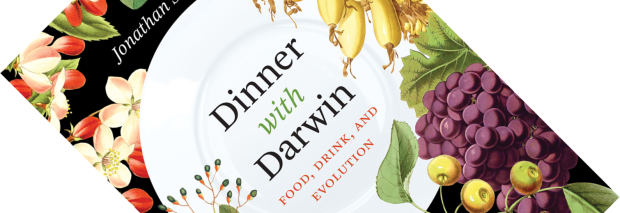Who could refuse such an invitation to dinner? In fourteen short chapters, Dinner with Darwin provides a smörgåsbord of topics on the role of food in human evolution and vice versa, many of which have been covered here in recent reviews. This is Jonathan Silvertown’s fourth book with the University of Chicago Press, and based on this, I would love to read his other books as well. Care to join me at the table?

“Dinner with Darwin: Food, Drink, and Evolution”, written by Jonathan Silvertown, published by The University of Chicago Press in November 2017 (hardback, 232 pages)
Silvertown starts off recapping Wrangham’s thesis put forth in Catching Fire: How Cooking Made Us Human, shortly mentioning the role of fossil teeth that Ungar elaborated upon in Evolution’s Bite: A Story of Teeth, Diet, and Human Origins. He then traces our migration around the globe following the heaps of empty shells we left around the world’s coastlines. Domestication secured our food supply, and the reader is given a summary of the beginning of agriculture in what is now the Middle East, something that was covered more in-depth in my recent review of Against the Grain: A Deep History of the Earliest States. We are also introduced to the seed collection efforts of Russian scientist Nikolai Ivanovich Vavilov (more on him in Where Our Food Comes From: Retracing Nikolay Vavilov’s Quest to End Famine and my review of Never Out Of Season: How Having the Food We Want When We Want it Threatens Our Food Supply and Our Future). Silvertown delves into the biochemistry of taste and the budding discipline of neurogastronomy, while a side-dish of fish allows him to discuss the importance of smell on our experience of flavours.
Meat and livestock are an entry point to discuss the genetic changes involved in domestication (in passing touching on Dmitry Belyaev’s work that was reviewed in How to Tame a Fox (and Build a Dog): Visionary Scientists and a Siberian Tale of Jump-Started Evolution). A chapter on vegetables sees Silvertown delving into the biochemistry of plant chemical defences, which we circumvent through cooking and food processing. Spices and herbs, on the other hand, are valued for their chemical compounds, as discussed in a second chapter. The chapter on desserts finally made me understand that not all sugars are created equal, revealing how fructose hoodwinks our metabolism, hormones, and digestion, and has become a prime suspect in obesity and diabetes. Microbes and fermentation (on which more in my review of The Rise of Yeast: How the Sugar Fungus Shaped Civilisation) play a role in the production of cheese, beer, and wine. We even get a crash course on the evolution of altruism when discussing the sharing of food.
” […] “A heroin addict is a bystander casualty of the war between poppies and caterpillars” (p. 154)”
Finally, Silvertown discusses the future of food. He summarises the first green revolution and role of Norman Borlaug (more on him in The Wizard and the Prophet: Two Remarkable Scientists and Their Conflicting Visions of the Future of our Planet) and stresses the importance of genetic engineering of crops in launching the second green revolution, which we will need to meet the challenges of a changing climate and expanding population. He makes short work of the non-sensical arguments put forth by the anti-GMO movement (something on which I have written much more in my review of Seeds of Science: Why We Got It So Wrong On GMOs). If anything, genetic engineering is as natural as it gets – nature has been doing it for a very long time, as shown by the discovery of horizontal gene transfer (the transfer of genetic material between species done by bacteria and viruses, see my review of Quammen’s book The Tangled Tree: A Radical New History of Life). Even the tools that we use, including the most recent discovery of CRISPR-Cas9 (see my review of A Crack in Creation: The New Power to Control Evolution for more details on that), have been taken straight from nature’s (cook)book.
It’s amazing that Silvertown manages to cram all this, and much more, in in under 200 pages. This book is a veritable feast for the popular science buff and food lover. The finger-licking selection of chapters provides a good entry point to various topics, summarising a lot of recent primary literature. Silvertown is a gifted writer who engages as much as he amuses. His observation (p. 154) that “A heroin addict is a bystander casualty of the war between poppies and caterpillars” is the kind of wit you would expect from a biologist. Before I opened this book, I wasn’t sure whether I would enjoy it much (I’m really not sure why anymore), but it turns out this book sits right in the middle of subjects I have been reading about a lot lately. This entertaining read would also make the perfect gift for your foodie friend.
Disclosure: The publisher provided a review copy of this book. The opinion expressed here is my own, however.

, hardback or ebook
Other recommended books mentioned in this review:
__________________________________________________________________
__________________________________________________________________
__________________________________________________________________












2 comments